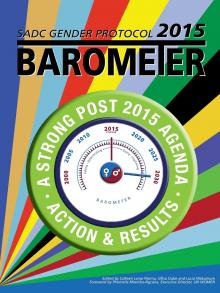Livrel(PDF, HTML) 406p.
(Gender Studies)
ISBN: 9780620704229
In August 2008, Heads of State of the Southern African Development Community adopted the ground-breaking SADC Protocol on Gender and Development. This followed a concerted campaign by NGOs under the umbrella of the Southern Africa Gender Protocol Alliance. The SADC Gender Protocol is the only sub-regional instrument that brings together existing global and continental commitments to gender equality and enhances these through time bound targets. Aligned to Millennium Development Goal Three, the original 28 targets of the Protocol targets expire in 2015. Now that 2015 is here, we need to step back, assess and reposition. In June 2014, SADC Gender Ministers agreed to review the targets of the Gender Protocol in line with the Sustainable Development Goals (SDGs). In May this year, ministers added that they want the Protocol to be accompanied by a Monitoring, Evaluation and Results Framework. The 2015 Barometer shows that implementation is now the biggest missing gap in the quest for gender equality. Now is the time to strengthen resolve, reconsider, reposition, and re-strategise for 2030. SADC GENDER PROTOCOL BAROMETER • 2015 2015 is here! In August 2008, Heads of State of the Southern African Development Community adopted the ground-breaking SADC Protocol on Gender and Development. This followed a concerted campaign by NGOs under the umbrella of the Southern Africa Gender Protocol Alliance. The SADC Gender Protocol is the only sub-regional instrument that brings together existing global and continental commitments to gender equality and enhances these through time bound targets. Aligned to Millennium Development Goal Three, the original 28 targets of the Protocol targets expire in 2015. Now that 2015 is here, we need to step back, assess and reposition. In June 2014, SADC Gender Ministers agreed to review the targets of the Gender Protocol in line with the Sustainable Development Goals (SDGs). In May this year, ministers added that they want the Protocol to be accompanied by a Monitoring, Evaluation and Results Framework. The 2015 Barometer shows that implementation is now the biggest missing gap in the quest for gender equality. Now is the time to strengthen resolve, reconsider, reposition, and re-strategise for 2030.



